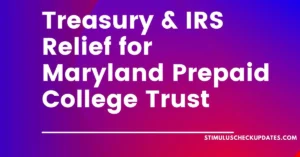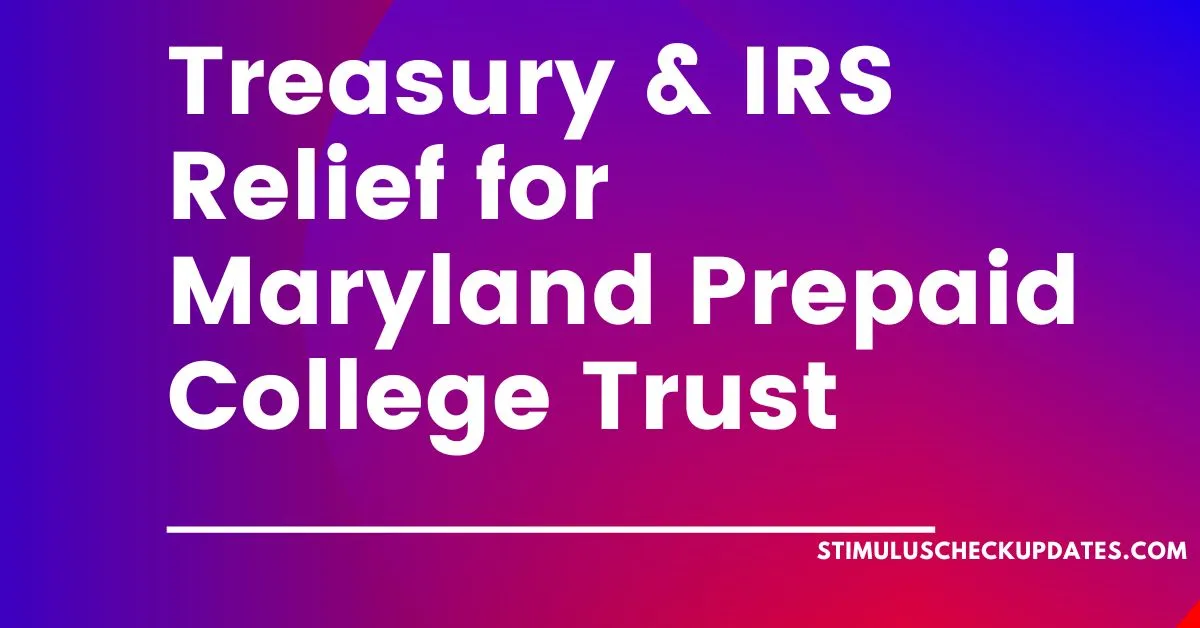The recent announcement by the Department of the Treasury and Internal Revenue Service (IRS) to provide exclusive relief for taxpayers facing challenges with rollovers involving Maryland Prepaid College Trust accounts is a noteworthy development. This relief, outlined in Notice 2024-23, temporarily lifts restrictions on rollovers between qualified tuition programs for those navigating issues specific to the Maryland Prepaid College Trust. To understand the Treasury & IRS Relief for Maryland Prepaid College Trust Rollovers, continue browsing this article.

Background on Federal Tax Law for Qualified Tuition Programs
- One Rollover Per 12 Months Rule: Federal tax law traditionally permits only one tax-free rollover in a 12-month period for the same beneficiary when moving assets between qualified tuition programs. This rule intends to discourage abuse and limit the tax-deferred growth benefits to once per year.
- Notice 2024-23 Creates Exemption: The IRS will not enforce the 12-month limitation for taxpayers making such rollovers, provided specific criteria outlined in Notice 2024-23 are met. This presents a unique reprieve to the normal restrictions.
- Section 529 Plans: Qualified tuition programs fall under Section 529 of the Internal Revenue Code. Section 529 contains tax benefits and rules related to these types of college savings accounts.
Qualifying Criteria for Relief Under Notice 2024-23
Taxpayers must meet certain conditions to qualify for the relief on Maryland Prepaid College Trust rollovers under Notice 2024-23. These criteria center on the timing, order, and recipient of the rollover transactions.
- Rollover Deadline: Taxpayers claiming relief must execute a rollover to or from the designated beneficiary’s Maryland Prepaid College Trust account before January 1, 2025. This sets a firm cutoff date to benefit from the relaxed limitations.
- 12-Month Limitation Exemption: The 12-month limitation, which would typically apply to sequential rollovers, will not be enforced by the IRS under this relief. Taxpayers can do multiple rollovers within a 12-month period.
- Must Follow Previous Rollover: The rollover in question must be preceded by a qualified rollover from the same designated beneficiary’s Maryland Prepaid College Trust account after December 31, 2021. There must already be one rollover on record.
- Same Beneficiary: The rollovers must involve the same designated beneficiary’s accounts. Relief is limited to rollovers for the same person.
Tax Implications and Reporting for Those Receiving Relief
Qualifying for relief under Notice 2024-23 comes with reporting responsibilities and implications for taxes owed.
- Excluded From Gross Income: If a taxpayer eligible for the relief receives a Form 1099-Q that includes a distribution treated as a qualified rollover under Notice 2024-23, the corresponding amount is not includible in gross income. This avoids owing income tax on the rollover.
- No Addition to Tax: Taxpayers eligible for relief need not file Form 5329, which would normally trigger a 10% addition to tax on the distribution. The 10% addition to tax does not apply to those qualifying rollovers.
- Record-Keeping Important: Taxpayers should maintain clear records documenting their qualified distributions and eligibility for relief under Notice 2024-23. This can support claims if any issues emerge down the line.
Additional Resources on Section 529 Plans
For a more comprehensive understanding of the tax code surrounding qualified tuition programs, taxpayers can explore Section 529 of the Internal Revenue Code along with IRS resources.
- Section 529 Overview: Section 529 of the tax code contains the rules, benefits, and limitations governing prepaid tuition and college savings plans. The once-per-12-months rollover restriction falls under Section 529.
- IRS Guidance on Section 529: The IRS.gov website has detailed resources on Section 529 plans and guidance on topics such as tax-free qualified distributions, account contributions, and the additional 10% tax on certain distributions.
- Further Questions: Taxpayers considering rollovers who need clarification can speak with a tax advisor or contact the IRS helpline with questions not addressed in published materials.
Evaluating the Benefits and Tradeoffs of Notice 2024-23
There are several key benefits taxpayers stand to gain through the relief in Notice 2024-23, along with some potential drawbacks to weigh.
Benefits
- Flexibility: The ability to do multiple sequential rollovers opens new options for Maryland Prepaid College Trust account holders to move funds between qualified tuition programs.
- Strategic Transfers: Taxpayers can make strategic transfers to optimize investment performance, minimize fees, or consolidate accounts.
- Avoid Penalties: Receiving relief avoids owing the 10% additional tax penalty on the distributions.
Potential Drawbacks
- Complexity: The complexity of executing multiple rollovers heightens the risk of administrative errors or mistakenly violating terms of relief.
- Planning Important: Taxpayers must plan rollover moves carefully and keep immaculate records to document meeting eligibility requirements.
- Short Window: The deadline of January 1, 2025, limits the relief period, forcing taxpayers to act quickly.
Bottom line
Notice 2024-23 provides time-limited relief for those dealing with Maryland Prepaid College Trust rollover challenges. By understanding the relief criteria, implications, and deadlines, and seeking expert counsel, taxpayers can strategically approach rollovers during this exclusive period of leniency from the IRS. For Maryland Prepaid College Trust account holders, Notice 2024-23 offers new possibilities previously restricted. This relief window closes on January 1, 2025, so taxpayers must act promptly. Overall, Notice 2024-23 allows eligible account holders to optimize their Section 529 portfolios for education cost savings in the near term.
FAQs
2. Q: How does the relief impact the traditional One Rollover Per 12 Months Rule in federal tax law?
The relief outlined in Notice 2024-23 creates an exemption to the One Rollover Per 12 Months Rule. The IRS will not enforce the 12-month limitation for taxpayers making rollovers, under specific criteria mentioned in the notice.
3. Q: What are the key benefits and potential drawbacks of availing relief under Notice 2024-23?
Benefits:
- Flexibility: Taxpayers gain the ability to do multiple sequential rollovers.
- Strategic Transfers: Optimize investments, minimize fees, and consolidate accounts.
- Avoid Penalties: Relief prevents the 10% additional tax penalty on distributions.
Potential Drawbacks:
- Complexity: Multiple rollovers increase the risk of errors.
- Planning Importance: Careful planning and record-keeping are crucial.
- Short Window: The relief period closes on January 1, 2025, requiring prompt action.
you may also like:


